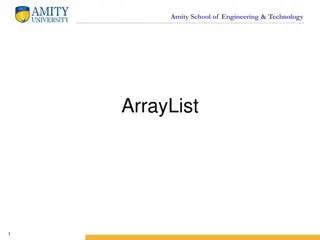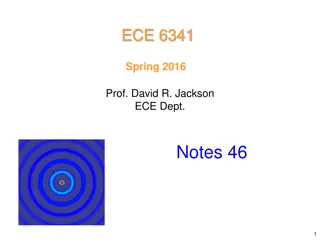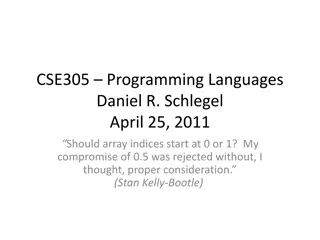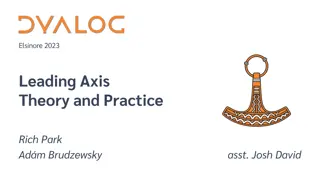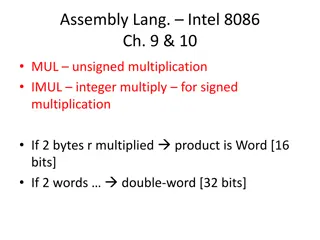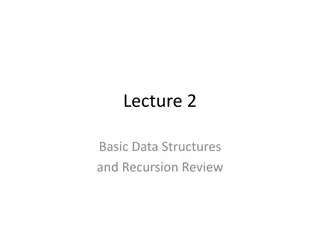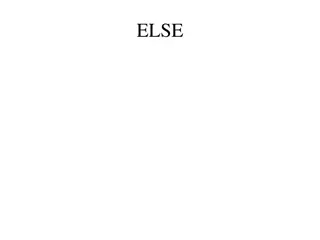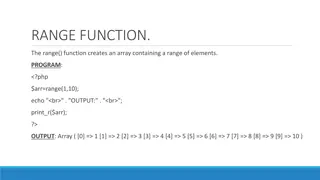Understanding Array Operations in C Programming
Dive into the world of arrays in C programming with this detailed lesson outline covering topics such as mean calculation, declarations, input handling, calculations, output generation, and more. Explore examples, declarations, and operations on arrays to enhance your programming skills.
Download Presentation

Please find below an Image/Link to download the presentation.
The content on the website is provided AS IS for your information and personal use only. It may not be sold, licensed, or shared on other websites without obtaining consent from the author. Download presentation by click this link. If you encounter any issues during the download, it is possible that the publisher has removed the file from their server.
E N D
Presentation Transcript
Array Lesson 1 Outline 1. 2. 3. 4. 5. 6. 7. 8. 9. 10. 11. 12. 13. 14. 15. 16. Array Lesson 1 Outline mean of a List of Numbers mean: Declarations mean: Greeting, Input mean: Calculation mean: Output mean: Compile, Run mean: 5 Input Values mean: 7 Input Values mean: One Line Different mean: Compile, Run for 5 mean: Compile, Run for 7 Scalars #1 Scalars #2 Another Scalar Example A Similar Program, with Multiplication A Similar Program, with a Twist 18. 19. 20. 21. 22. 23. 24. 25. 26. 27. 28. 29. 30. 31. 32. 33. 34. 35. Arrays Array Element Properties Array Properties #1 Array Properties #2 Array Properties #3 Array Properties #4 Array Properties #5 Array Indices #1 Array Indices #2 Multidimensional Arrays & 1D Arrays Array Declarations #1 Array Declarations #2 Array Declarations #3 Assigning a Value to an Array Element Array Element Assignment Example Getting Array Element Value with scanf Array Element scanf Example #1 Array Element scanf Example #2 17. Array Lesson 1 CS1313 Spring 2024 1
mean of a List of Numbers Consider a list of real numbers of length n elements: x1, x2, x3, , xn The mean (average) of this list is: (x1 + x2 + x3+ + xn) / n Array Lesson 1 CS1313 Spring 2024 2
mean: Declarations #include <stdio.h> int main () { /* main */ const float initial_sum = 0.0; const int number_of_elements = 5; const int first_element = 0; const int program_success_code = 0; float input_value[number_of_elements]; float sum; float mean; int element; Array Lesson 1 CS1313 Spring 2024 3
mean: Greeting, Input printf("I'm going to calculate the\n"); printf(" mean of a list "); printf("of length %d values.\n", number_of_elements); printf("What are the %d values of the list?\n", number_of_elements); for (element = first_element; element < number_of_elements; element++) { scanf("%f", &input_value[element]); } /* for element */ Array Lesson 1 CS1313 Spring 2024 4
mean: Calculation sum = initial_sum; for (element = first_element; element < number_of_elements; element++) { sum += input_value[element]; } /* for element */ mean = sum / number_of_elements; Array Lesson 1 CS1313 Spring 2024 5
mean: Output printf("The %d input values of the list are:\n", number_of_elements); for (element = first_element; element < number_of_elements; element++) { printf("%f ", input_value[element]); } /* for element */ printf("\n"); printf("The mean of the %d values", number_of_elements); printf(" in the list is %f.\n", mean); return program_success_code; } /* main */ Array Lesson 1 CS1313 Spring 2024 6
mean: Compile, Run % gcc -o mean5 mean5.c % mean5 I'm going to calculate the mean of a list of length 5 values. What are the 5 values of the list? 123.25 234.50 345.75 456.00 567.25 The 5 input values of the list are: 123.250000 234.500000 345.750000 456.000000 567.250000 The mean of the 5 values in the list is 345.350006. Array Lesson 1 CS1313 Spring 2024 7
mean: 5 Input Values #include <stdio.h> int main () { /* main */ const float initial_sum = 0.0; const int number_of_elements = 5; const int first_element = 0; const int program_success_code = 0; float input_value[number_of_elements]; float sum; float mean; int element; Array Lesson 1 CS1313 Spring 2024 8
mean: 7 Input Values #include <stdio.h> int main () { /* main */ const float initial_sum = 0.0; const int number_of_elements = 7; const int first_element = 0; const int program_success_code = 0; float input_value[number_of_elements]; float sum; float mean; int element; The rest of the program is EXACTLY THE SAME! Array Lesson 1 CS1313 Spring 2024 9
mean: One Line Different % diff mean5.c mean7.c 6c6 < const int number_of_elements = 5; --- > const int number_of_elements = 7; The diff Unix command compares two files of text and shows which lines are different. The only statement that differs between mean5.c and mean7.c is the declaration of number_of_elements. Array Lesson 1 CS1313 Spring 2024 10
mean: Compile, Run for 5 % gcc -o mean5 mean5.c % mean5 I'm going to calculate the mean of a list of length 5 values. What are the 5 values of the list? 123.25 234.50 345.75 456.00 567.25 The 5 input values of the list are: 123.250000 234.500000 345.750000 456.000000 567.250000 The mean of the 5 values in the list is 345.350006. Array Lesson 1 CS1313 Spring 2024 11
mean: Compile, Run for 7 % gcc -o mean7 mean7.c % mean7 I'm going to calculate the mean of a list of length 7 values. What are the 7 values of the list? 12.75 23.75 34.75 45.75 56.75 67.75 78.75 The 7 input values of the list are: 12.750000 23.750000 34.750000 45.750000 56.750000 67.750000 78.750000 The mean of the 7 values in the list is 45.750000. Array Lesson 1 CS1313 Spring 2024 12
Scalars #1 % cat scalar_names.c #include <stdio.h> int main () { /* main */ int b, c, d, e, f; b = 0; c = 2; d = 4; e = 6; f = 8; printf("b = %d\n", b); printf("c = %d\n", c); printf("d = %d\n", d); printf("e = %d\n", e); printf("f = %d\n", f); return 0; } /* main */ % gcc -o scalar_names \ scalar_names.c % scalar_names b = 0 c = 2 d = 4 e = 6 f = 8 Note that, in Unix, a backslash at the end of a Unix command line means: continue this Unix command on the next line. Array Lesson 1 CS1313 Spring 2024 13
Scalars #2 % cat scalar_names.c #include <stdio.h> int main () { /* main */ int b, c, d, e, f; b = 0; c = 2; d = 4; e = 6; f = 8; printf("b = %d\n", b); printf("c = %d\n", c); printf("d = %d\n", d); printf("e = %d\n", e); printf("f = %d\n", f); return 0; } /* main */ All of the variables in the program are simple int variables. Each of the individual int variables has a single name, a single address, a single data type and a single value. Such variables, whether their type is int, float, char or whatever, are referred to as scalarvariables. Array Lesson 1 CS1313 Spring 2024 14
Another Scalar Example % cat scalar_a.c #include <stdio.h> int main () { /* main */ int a0, a1, a2, a3, a4; a0 = 0; a1 = 2; a2 = 4; a3 = 6; a4 = 8; printf("a0 = %d\n", a0); printf("a1 = %d\n", a1); printf("a2 = %d\n", a2); printf("a3 = %d\n", a3); printf("a4 = %d\n", a4); return 0; } /* main */ % gcc -o scalar_a \ scalar_a.c % scalar_a a0 = 0 a1 = 2 a2 = 4 a3 = 6 a4 = 8 The only difference between this program and the previous program is the names of the scalar variables (and therefore some of the output). Array Lesson 1 CS1313 Spring 2024 15
A Similar Program, with Multiplication % cat scalar_mult.c #include <stdio.h> int main () { /* main */ int a0, a1, a2, a3, a4; a0 = 0 * 2; a1 = 1 * 2; a2 = 2 * 2; a3 = 3 * 2; a4 = 4 * 2; printf("a0 = %d\n", a0); printf("a1 = %d\n", a1); printf("a2 = %d\n", a2); printf("a3 = %d\n", a3); printf("a4 = %d\n", a4); return 0; } /* main */ % gcc -o scalar_mult \ scalar_mult.c % scalar_mult a0 = 0 a1 = 2 a2 = 4 a3 = 6 a4 = 8 Notice that, in this program, the values of the scalar variables are obtained by multiplying a constant by the number associated with the scalar variable. Array Lesson 1 CS1313 Spring 2024 16
A Similar Program, with a Twist % cat array_mult.c #include <stdio.h> int main () { /* main */ int a[5]; a[0] = 0 * 2; a[1] = 1 * 2; a[2] = 2 * 2; a[3] = 3 * 2; a[4] = 4 * 2; printf("a[0] = %d\n", a[0]); printf("a[1] = %d\n", a[1]); printf("a[2] = %d\n", a[2]); printf("a[3] = %d\n", a[3]); printf("a[4] = %d\n", a[4]); return 0; } /* main */ % gcc -o array_mult \ array_mult.c % array_mult a[0] = 0 a[1] = 2 a[2] = 4 a[3] = 6 a[4] = 8 Huh? Array Lesson 1 CS1313 Spring 2024 17
Arrays int a[5]; An arrayis a special kind of variable. Like a scalar variable, an array has: a name; an address; a data type. But instead of an array having exactly one single value, it can have multiple values. Each of these values is referred to as an elementof the array. If you re familiar with vectors in mathematics, you can think of an array as the equivalent idea, but in computing instead of in mathematics. Array Lesson 1 CS1313 Spring 2024 18
Array Element Properties Each of the elements of an array is just about exactly like a scalar variable of the same data type. An element of an array has: 1. a name, which it shares with all of the other elements of the array that it belongs to; 2. an address, which we ll learn about shortly; 3. a data type, which it shares with all of the other elements of the array that it belongs to; 4. a single value. But, an element of an array also has: 5. an index, which we ll learn about shortly. Array Lesson 1 CS1313 Spring 2024 19
Array Properties #1 int a[5]; An array as a whole has the following properties: 1. It has a data type, which is the data type of each of its elements; for example, int. Array Lesson 1 CS1313 Spring 2024 20
Array Properties #2 int a[5]; An array as a whole has the following properties: 2. It as a dimensionattribute, sometimes called its length, which describes the number of elements in the array; for example, [5]. Array Lesson 1 CS1313 Spring 2024 21
Array Properties #3 int a[5]; An array as a whole has the following properties: 3. It has exactly as many values as it has elements, and in fact each of its elements contains exactly one of its values. Array Lesson 1 CS1313 Spring 2024 22
Array Properties #4 int a[5]; An array as a whole has the following properties: 4. Its elements are accessed via indexingwith respect to the variable name; for example, a[2] = 7; Array Lesson 1 CS1313 Spring 2024 23
Array Properties #5 int a[5]; An array as a whole has the following properties: 5. Its elements are contiguousin memory; for example, a[0] a[1] a[2] a[3] a[4] ? ? ? ? ? a[0] ???????? Address 12340 a[1] ???????? Address 12344 a[2] ???????? Address 12348 a[3] ???????? Address 12352 a[4] ???????? Address 12356 Array Lesson 1 CS1313 Spring 2024 24
Array Indices #1 int a[5]; We access a particular element of an array using indexnotation: a[2] This notation is pronounced a of 2 or a sub 2. The number in square brackets for example, the 2 in a[2] is called the indexor subscriptof the array element. Array indices are exactly analogous to subscript numbers in mathematics: a0, a1, a2, a3, a4 Array Lesson 1 CS1313 Spring 2024 25
Array Indices #2 int a[5]; An individual element of an array for example, a[2] has exactly the same properties as a scalar variable of the same data type except for being accessed via indexing. Notice that the elements of an array are numbered from 0 through (length - 1); in the above example, the elements of a are a[0], a[1], a[2], a[3], a[4] Array Lesson 1 CS1313 Spring 2024 26
Multidimensional Arrays & 1D Arrays An array can have multiple dimensions: int array2d[8][5]; In CS1313, we re going to focus on arrays of only one dimension. A one-dimensional array is sometimes called a vector, because of the close relationship between arrays in computing and vectors in mathematics. A two-dimensional array is sometimes called a matrix. A three-dimensional array is sometimes called a field. Array Lesson 1 CS1313 Spring 2024 27
Array Declarations #1 The general form of an array declaration is: typearrayname1[dimension1],arrayname2[dimension2],... ; For example: int a[8], b[4], c[9]; causes the compiler to set up three int arrays in memory. Array Lesson 1 CS1313 Spring 2024 28
Array Declarations #2 int a[5], b[4], c[9]; causes the compiler to set up three int arrays in memory, like so: a[0] a[1] a[2] a[3] a[4] ? ? ? ? ? b[0] b[1] b[2] b[3] ? ? ? ? c[0] c[1] c[2] c[3] c[4] c[5] c[6] c[7] c[8] ? ? ? ? ? ? ? ? ? Array Lesson 1 CS1313 Spring 2024 29
Array Declarations #3 int a[8], b[4], c[9]; In principle, these arrays could be remote from each other in memory (for example, a could start at address 12340, b could start at address 67890 and c could start at address 981439294). In practice, they are usually contiguous or almost contiguous in memory; that is, the last byte of array a will typically be right next to the first byte of array b, and the last byte of array b will typically be right next to the first byte of array c. However, the compiler isn t requiredto make the different arrays contiguous in memory. The only contiguity constraint is that, within each array, all of the elements are contiguous and sequential. Array Lesson 1 CS1313 Spring 2024 30
Assigning a Value to an Array Element Because an individual array element is exactly analogous to a scalar variable, we can assign or input a value into it in exactly the same ways that we assign or input values into scalar variables. For example, we can use a scalar assignment for each individual element. Array Lesson 1 CS1313 Spring 2024 31
Array Element Assignment Example % cat arrayeltassn.c #include <stdio.h> int main () { /* main */ int a[3]; % gcc -o arrayeltassn \ arrayeltassn.c % arrayeltassn a[0] = 5 a[1] = 16 a[2] = -77 a[0] = 5; a[1] = 16; a[2] = -77; printf("a[0] = %d\n", a[0]); printf("a[1] = %d\n", a[1]); printf("a[2] = %d\n", a[2]); return 0; } /* main */ Array Lesson 1 CS1313 Spring 2024 32
Getting Array Element Value with scanf Just as we can assign a value to an individual array element, we can usescanfto obtain the value of each individual array element. Array Lesson 1 CS1313 Spring 2024 33
Array Element scanf Example #1 #include <stdio.h> int main () { /* main */ float a[3]; printf("Input a[0],a[1],a[2]:\n"); scanf("%f %f %f", &a[0], &a[1], &a[2]); printf("a[0] = %f\n", a[0]); printf("a[1] = %f\n", a[1]); printf("a[2] = %f\n", a[2]); return 0; } /* main */ Array Lesson 1 CS1313 Spring 2024 34
Array Element scanf Example #2 % gcc -o arrayeltread arrayeltread.c % arrayeltread Input a[0],a[1],a[2]: 5.5 16.16 -770.770 a[0] = 5.500000 a[1] = 16.160000 a[2] = -770.770020 Array Lesson 1 CS1313 Spring 2024 35




